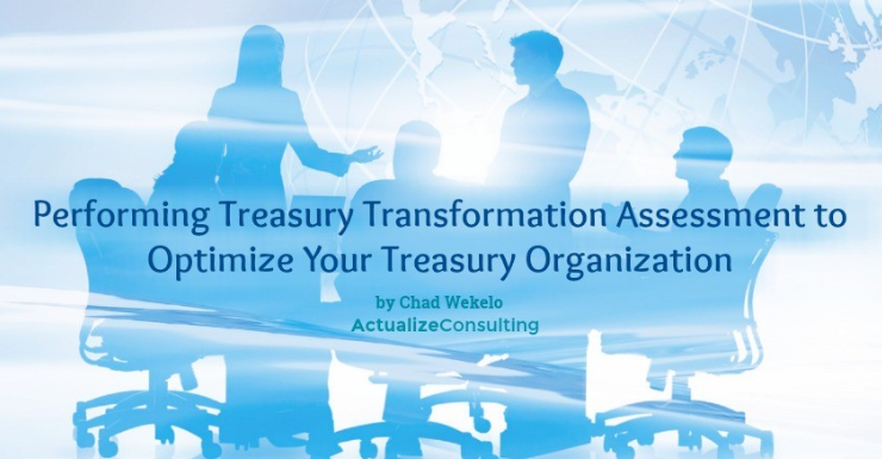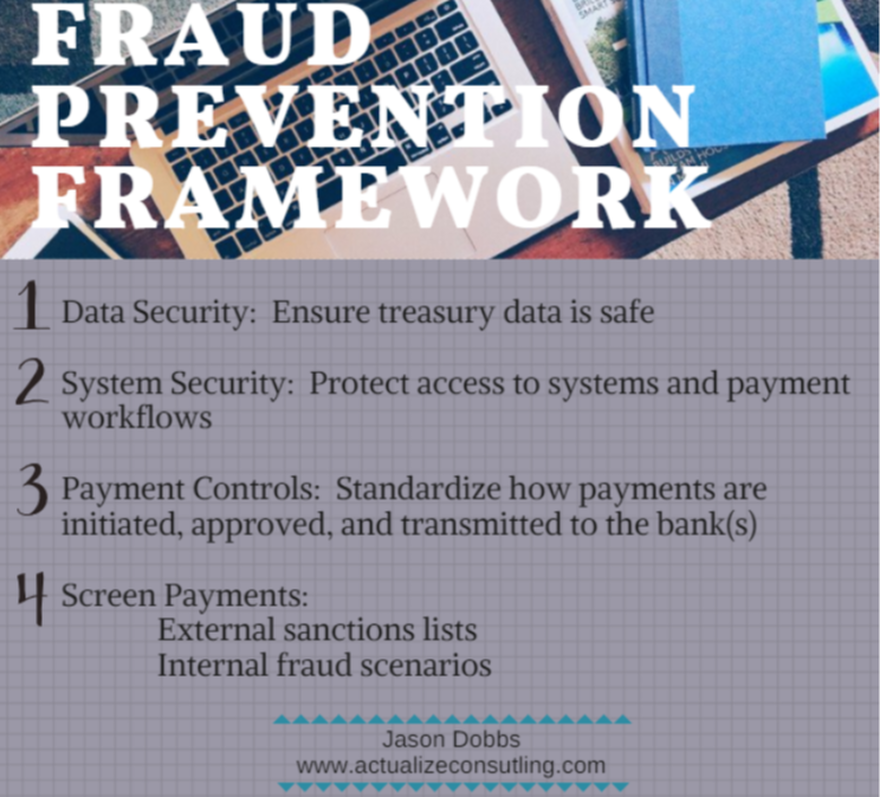|
PERFORMING TREASURY TRANSFORMATION ASSESSMENT TO OPTIMIZE YOUR TREASURY ORGANIZATION TIPS
Chad Wekelo, Principal and Owner at Actualize Consulting. Follow the below steps to perform a Treasury Transformation Assessment in order to optimize your treasury organization: 1.) Define Scope To optimize the treasury initiative, a transformation assessment should be conducted at your organization. The first step in designing this assessment is to define the scope. When developing the scope, all items should be clearly defined and prioritized. Ensure you understand and incorporate the strategic direction of the organization into a plan, obtaining leadership support and commitment from all impacted stakeholders. Create measurable objectives and incorporate them into fabric of the project. 2.) Current State Definition When defining the current state, you should leverage a questionnaire to gather comprehensive and consistent information obtained from a cross section of all groups. Follow up by reviewing the questionnaire responses and tailor interviews based upon the replies. Combining this information with the capability assessment of systems and resources, the current processes can be documented to focus on obtaining data required to drive the key objectives. Finally, actively engage the stakeholders to review and validate these results. 3.) Future State Design Next, the future state should be outlined and designed by first drafting the process flow and creating an ideal future state technology architecture. Include multiple versions to coincide with the roadmap phases. To achieve the desired future state model, the opportunities should be designed to streamline the processes, roles, and responsibilities. Define staffing skill requirements by office and functional area to determine any required realignment of processes or resources to finalize the desired future state. 4.) Prioritized Roadmap A roadmap should then be outlined. A roadmap is a strategic plan describing the steps an organization needs to take to achieve its stated outcomes and goals. It’s important to clearly outline objectives and link tasks and priorities for action in the near, medium, and long term. Create an impact assessment to weigh the benefits versus cost and time required to achieve the desired outcome. Outline the timeline, resources and budget required to achieve the stated objectives and prepare business cases. Metrics and milestones should be defined to allow regular tracking of progress towards the roadmaps' ultimate goals. 5.) Execution and Evaluating Success Finally, ensure firm leadership backs the project and key stakeholders are consistently engaged, participating, and accountable. In the beginning, utilize a phased approach to obtain early wins and minimize project risk. Lastly, incorporate milestones into the project plan to leverage gating criteria including the stakeholder sign-off. If you would like assistance in developing a transformation assessment, you can reach out to me at [email protected].
0 Comments
4 STRATEGIES FOR TREASURY TO PROTECT AGAINST PAYMENT FRAUD
Jason Dobbs, Senior Manager, Treasury & Capital Markets To minimize the increased threat of fraud, it is imperative for treasury controls to match internal compliance, follow risk guidelines, and implement necessary fraud prevention policies. 1. Data Security Host information on an external cloud to ensure treasury data is accessed safely. To determine which cloud to utilize, ask the following questions:
2. System Security Be sure the system remains secure from the start by taking application security into account. Cyber attackers prey on weak login and authentication procedures. Create a strong and "difficult to deduce" identification and password. Establish a combination of password controls as follows:
3. Payment Controls Upgrading payment workflows are an opportunity to increase the controls found in payment policies. A consistent security protocol as well as one single set of limits should be utilized. Once outside the safety-net of the application's security, be sure a streamline and secure process is followed with these key elements: the encryption of data being transferred, arrangement of an automated confirmation of receipt, and a single source of record for the data. Finally, visibility of the payment policies must exist within the workflow and real time visibility of auditable events (such as approvals). It is critical that these controls be standardized across all payments, in all geographies. 4. Screen Payments Screening payments not only ensures regulatory requirements are met, but helps to prevent payments do not fall into unintended hands, but ensures regulator. Review screening within payment systems against the OFAC, EU, and UN sanction/security lists and custom scenarios to determine what the bank will discover. To greatly reduce the chance of fraud, align payment policies with screening rules. These security controls even helped uncover the penetration at the bank of Bangladesh. If you would like assistance in developing a framework for fraud prevention, you can reach out to me at [email protected]. I will also be attending the NYCE Conference Jay 30- June 1. Let’s connect. For more information visit http://www.actualizeconsulting.com/treasury.html Priscila Nagalli, CFA, CTP, Director of Treasury and Capital Markets
How to approach forecasting effectively and most important, making it realistic, achievable and transferable leveraging technology. Below are 8 key tips to establish effective cash forecasting: 1. Information Availability Ensure quality data is available to position the project for success. The accounting budget is a good base to develop cash forecasting as long as the timing and discounts are taken into account. There are many areas of the company which provide input into the cash forecasting, these areas include but are not limited to:
2. Company Culture It can be hard to maintain an accurate forecast as something is always happening internally or in the market. It is essential to foster an environment stressing the importance of cash flow management while continuing to communicate and share information throughout the entire process. 3. Internal Systems It is critical to know the system infrastructure. A cash forecasting technology can be utilized to create, simplify, streamline, and automate the forecasting process. Cash forecasting technology automatically populates known cash flows and constantly evaluates forecast effectiveness. This allows modifications to the forecast to be made in real-time based upon a seamless variance analysis. 4. Communication & Training Initially, communication and training around the forecasting objectives and process should be provided to all areas. Then open communication should continue between the business partners. It is the responsibility of subsidiaries to deliver accurate forecasting information to treasury and for treasury to provide forecasts based upon the feedback to the business units. 5. Accuracy It is essential that reported information be reliable and accurate. Since cash forecasting may be updated daily, an evaluation of the forecasts versus the actuals should be conducted regularly. This analysis can identify trends, which can be discussed to ensure the data remains precise and everyone is aware and engaged on the forecasts. 6. Harmonize Forecasts The creation of transparency should span across the organization. This allows various business areas to ensure that all related forecasts concur to generate the central view. 7. Objectives Establish a forecasting process with well-defined objectives and ensure these objectives are clear and understood by all areas. 8. Approach It is important to develop an approach to forecast and gain consensus on this approach with all business partners. Five simple questions provided by Aetna can be asked when evaluating your forecast process: 1. What’s the purpose of creating a cash flow forecast? 2. Who is audience of the data? 3. Who owns / updates the forecast? Treasury 4. Who contributes to the forecast? Business partners 5. How do you evaluate the effectiveness of your forecast? For more information regarding our services, please visit our website (www.actualizeconsulting.com/treasury.html) or reach out to me directly at [email protected] |
News OverviewLatest release news and tips for your Kyriba implementation. Categories
All
Actualize ServicesArchives
December 2020
|
- Home
- News
-
Kyriba ▼
- On-Boarding
- Bank Account Management
- Bank Connectivity
- Bank Fee Analysis
- Bank Statements
- Business Intelligence
- Cash & Forecasting
- Cash Accounting
- Financial Accounting
- Financial Transactions >
- Fraud & Compliance
- GL Reconciliation
- Hedge Accounting
- In-House Banking
- Netting
- Payments
- SSO/SMS
- System Administration
- Valuations
- Mid Market ▼
- Best Practices ▼
-
Actualize Resources ▼
- New Kyriba Consultants
-
Technical Resources ▼
>
- More Education ▼ >
- Bank Account Management
- Bank Fee Analysis
- Bank Connectivity
- Bank Statements
- Kyriba Reporting ▼ >
- Cash & Forecasting
- Cash Accounting
- Core Data
- Connectivity ▼ >
- Data Exchange
- Financial Accounting
- Financial Transactions
- Fraud & Compliance
- GL Reconciliation
- In-house Banking
- Liquidity Planning
- Market Data & MTM
- Netting
- Payments
- Supply Chain Finance
- System Admin & SSO
- Valuations & Risk, Hedge Accounting
- News & General ▼ >
- Project Resources ▼ >
- RPA
- Sales and Account Management
- Training Portal Requests
- Contact




 RSS Feed
RSS Feed